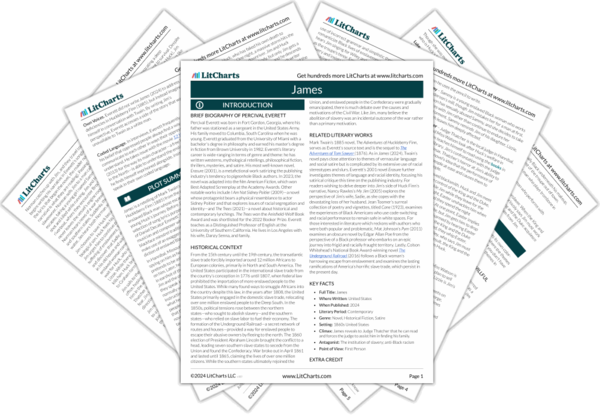Speech, Performance, and Willful Ignorance
Throughout James, the titular character—referred to as Jim for most of the novel—uses language as a mode of performance. Whenever white people are present, Jim and other enslaved Black people speak in what they call “slave talk”—a heightened diction intended to support the prevalent white view that Black people are less intelligent. On their own, though, Jim and the others speak more fluently and naturally, and they can effortlessly switch between the two languages…
read analysis of Speech, Performance, and Willful IgnoranceIdentity, Narrative, and Agency
As a reimagining of Mark Twain’s The Adventures of Huckleberry Finn, James seeks to reclaim that narrative for its eponymous character by centering the perspective of the frequently stereotyped enslaved Black man. While Jim has been taught that his identity is irrevocably tied to his enslavement, even before the novel begins, he has taken measures to redefine himself on his own terms by learning to read and write. Jim’s struggle with his identity is…
read analysis of Identity, Narrative, and AgencyRacism, Dehumanization, and Hypocrisy
Through Jim’s interactions with white people and his hallucinated encounters with famous philosophers and writers, James examines how racism and enslavement inherently involve the hypocritical denial of another person’s humanity. Throughout the novel, white characters frequently refer to Jim as if he is something other than a human being. While beating Jim, the Duke declares that “he ain’t no proper people. He don’t feel pain like we do.” It is worth noting that, by…
read analysis of Racism, Dehumanization, and Hypocrisy
Innocence vs. Disillusionment
Throughout James, Huck’s youthful innocence sharply contrasts with Jim’s increasing worldly disillusionment. As in Twain’s novel, Huckleberry Finn is a mischief-maker with a fondness for adventure. The novel begins with him and Tom Sawyer playing a prank on Jim, who plays along because “[i]t always pays to give white folks what they want.” Despite lumping Huck in with other “white folks,” Jim feels genuine sympathy for the boy, telling Old Luke…
read analysis of Innocence vs. DisillusionmentFamily, Alliance, and Loyalty
As opposed to Twain’s novel, which focuses on Huck’s whimsical adventures along the Mississippi, James highlights a darker narrative: Jim’s struggle to free himself, his wife, Sadie, and his daughter, Lizzie from slavery. Jim’s family is his primary motivation for running away from the threat of being sold, as he does not want to be permanently separated from them. Connection—familial or otherwise—also plays a central role in many of the novel’s side…
read analysis of Family, Alliance, and Loyalty






